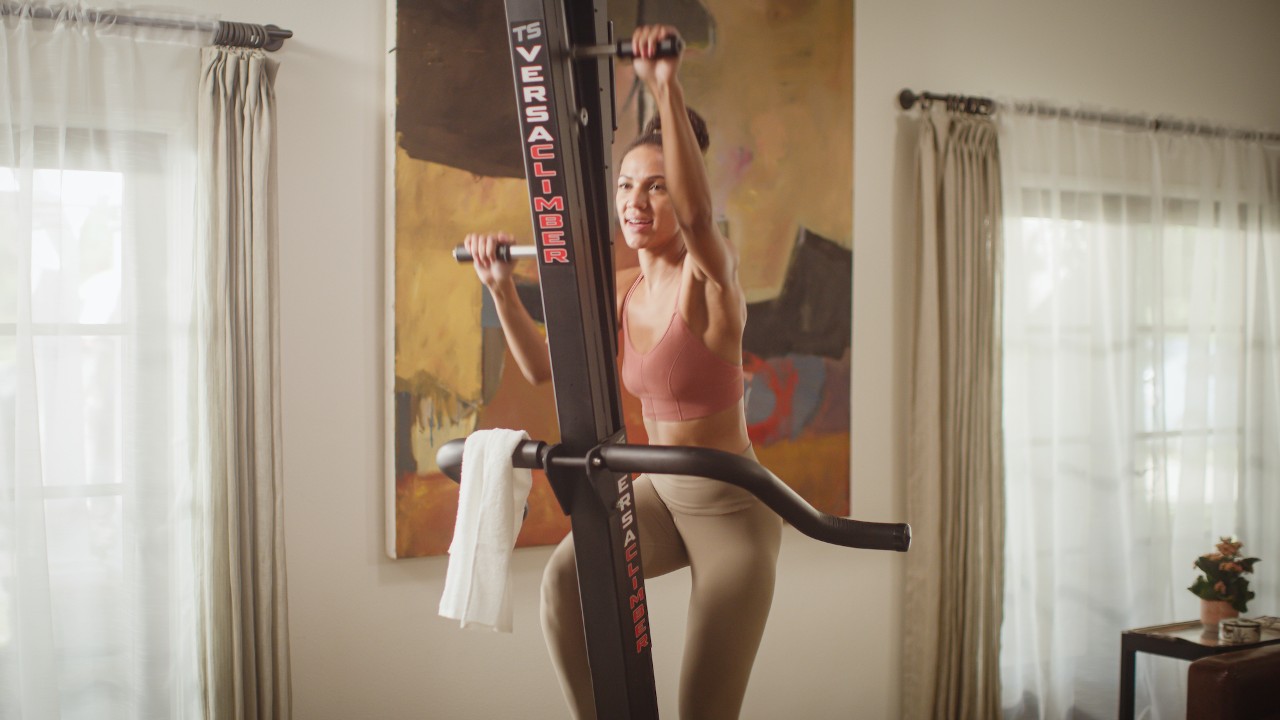The VersaClimber Offers An Unrivalled No-Impact Cardio Workout
Burn calories without risking injury on the criminally undervalued Versaclimber

Even if you’re lucky enough to be a member of a gym that has a VersaClimber, the chances are you’ve never dared to use it. Let’s face it, trying new equipment is intimidating – there’s a clear risk of looking very stupid indeed.
However, the VersaClimber is worth the risk because it can deliver a workout unlike anything you can get from other cardio machines. We’ve got the low-down from two experts on the benefits of the VersaClimber, how to use this cardio machine, and a 15-minute workout for you to try.
“The key benefit of using a VersaClimber over any other cardio machine is that it provides a zero-impact, full-body cardio workout,” says James Pisano, fitness director at Sweat by BXR in London, which offers group classes on the VersaClimber.
The basic movement on the VersaClimber is simple to understand. You jump on and push the pedals with your feet and pull the handles with your hands. You can mix up the length of your strides and your pace to vary a workout, or isolate your arms or legs.
“It’s easy to navigate the machine,” says Remi Mobed, a musculoskeletal physiotherapy consultant who’s also an ambassador for VersaClimber. “There’s minimal set-up required. You do need to change the level of resistance, but that is pretty much the only thing you need to adjust.”
The machine moves as fast as you do and instantly adapts to your effort level, which makes it ideal for HIIT workouts, especially since you can push yourself as hard as possible without worrying about impact injuries.
“The machine allows you to offload the ground reaction forces which you would get from something like running,” says Mobed. This makes it ideal for anyone coming back from a lower-limb injury or operation, as long as they’re in the mid-stage point of their rehab. “It’s not appropriate for those who are immediately post-op,” says Mobed, “but it’s a good halfway house when you are through that post-op phase, but not quite at running fitness stage.”
Sign up for workout ideas, training advice, reviews of the latest gear and more.
In fact, using the VersaClimber sounds like a fantastic idea for many reasons, right up till the moment you step on and realise just how hard it is.
“Anybody with any heart issues or who has suffered any major medical issues should always consult a doctor before getting on a piece of equipment like that,” says Mobed.
To get started on the VersaClimber, try this 15-minute workout from Pisano.
VersaClimber Workout

1 Short strides
Before you hit the workout proper, warm up with three minutes of faster, shorter strides on the machine.
2 Duck walks
Hold the rails rather than the handles of the VersaClimber – this exercise is designed to isolate the legs. Drop into a deep squat, hold the postition then start stepping, driving your heel as low as possible with each step. Keep your head up and chest open as you go. Do this for four minutes in total, 30sec on and 30sec off.
3 Full range intervals
Now you’re ready to get your whole body moving, working in intervals of 45sec on, 15sec off. Start each interval with short, fast steps for 15sec, then move into full extensions where you open your reach with your arms and your legs fully while maintaining the pace. Do this for 15sec, then return to shorter steps for the final 15sec. Keep your head up and your body as straight as possible throughout.
4 Underhand grip
The change in grip means you’ll hit your biceps and lats harder, but the block works to the same timings – four minutes in total, broken down into 45sec periods of work and 15sec of rest. As with the normal grip, break the 45sec interval down into 15sec of short strides, 15sec of full extensions and 15sec of short strides. Make sure you pull in tight so your elbow gets as low as possible before pulling with the other arm.

Nick Harris-Fry is a journalist who has been covering health and fitness since 2015. Nick is an avid runner, covering 70-110km a week, which gives him ample opportunity to test a wide range of running shoes and running gear. He is also the chief tester for fitness trackers and running watches, treadmills and exercise bikes, and workout headphones.
